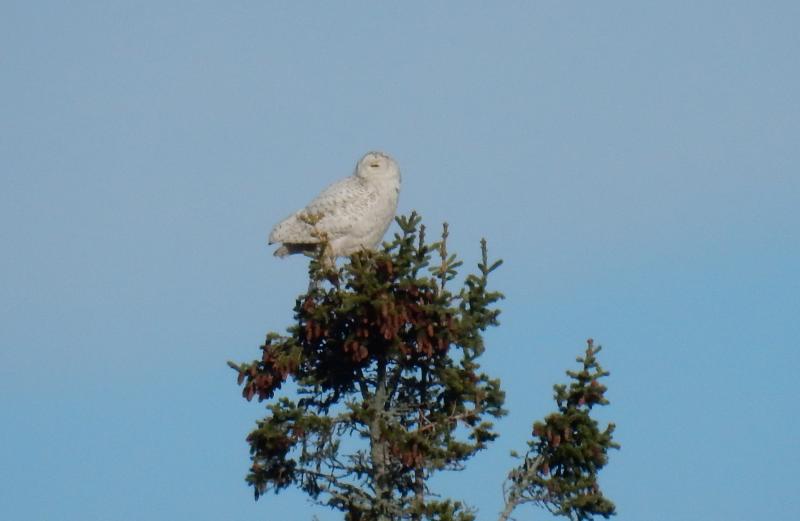Birds are always surprising us. May is that wonderful month when we revel in the diversity and abundance of migrant birds returning north from their southern wintering grounds. But this May, our most shocking sightings were not returning migrants. Instead, we were stunned to see two different species that come south to Maine in winter and normally are well on their way back north to Canada or Alaska by the time May rolls around.
One of these late-lingering species was a snowy owl—you can’t get more wintery than that! It had been found hanging around some of the buildings beside the Hancock County Airport in Trenton, the last town on the mainland before you cross the bridge to Mount Desert Island. We found out about it through the Maine birding listserve, so when we were in the Bar Harbor area after leading a bird walk for the Natural Resources Council of Maine, we decided to stop by to look for it. It didn’t take long to find it; when we arrived there was already a carload of birders there snapping photos as the owl scanned for prey from the various trees and telephone poles. Here we were celebrating International Migratory Bird Day in mid-May after having tallied a variety of warblers that morning that had just arrived from Central and South America, enjoying the warm afternoon sun and looking at a bird whose compatriots were mostly far to the north in the cold, windy conditions of the Arctic and Subarctic. It was certainly the latest-occurring snowy owl we had seen in Maine.
An equally astonishing May-lingering species for us was the one we like to call the “grizzly bear bird.” The species is really known as the bohemian waxing but we call it the “grizzly bear bird” because its documented breeding range overlaps extensively with the remaining range of the grizzly bear. Of course the grizzly bear once occurred across much of the western U.S.—Lewis and Clark even encountered some out in the open prairies. Now it is largely confined to northwestern Canada and Alaska, although there are a few down in the Rockies in and near Yellowstone National Park. Bohemian waxwings nest in northwestern Canada and into Alaska but sweep southeast to southeastern Canada and Maine during the winter, sometimes occurring in large flocks as they search out crabapple trees and gobble down the frozen fruits. We have seen bohemian waxwings that have lingered into April some years but on May 13, while birding at Viles Arboretum in Augusta, we heard the telltale trilling calls—a little lower pitched than the expected cedar waxwing that spends summers here—of a pair of bohemian waxwings. We spotted them feeding up in a tree behind the nature center and were so surprised that we took some photos and video of the two. The next day, other birders found them, too. Since there were two of them we wondered if they might do something crazy and stay to nest, even though they are so many hundreds of miles from their expected breeding range.
Why might these birds have lingered so long here on their wintering grounds when most of their kind were already back north? It is all conjecture, of course, but we do know some possible reasons. Sometimes a bird that is underweight or sick may have to take extra time trying to secure food and get back to a healthy enough state to make the long journey back home. Immature birds sometimes are known to linger down on the wintering range their first year or to go back to the breeding range late in the season.
Whether they stay here or eventually make it for the summer, we wish them well and are grateful for the surprise they provided!
































.png)
.png)
